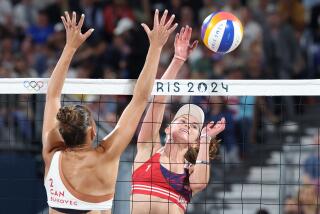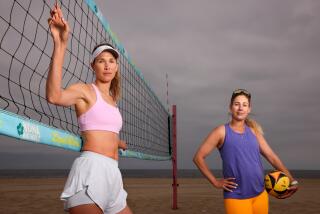Volleyball players weigh options as AVP struggles
- Share via
Sean Scott is a professional beach volleyball player, and that’s been his full-time occupation since 1999.
But since last week, he’s been worried. The volleyball tour he plays on, the Assn. of Volleyball Professionals, canceled its season because it ran out of money.
FOR THE RECORD:
Professional volleyball: An article in Friday’s Sports section about the effects on players of the cancellation of the Assn. of Volleyball Professionals season said the Manhattan Beach Open, previously an AVP event, began that day. The event was to start Saturday morning. —
“My options are basically to try and play overseas, find a domestic tour should there be one, or retire from the sport and find a job,” Scott said.
That last option, Scott admitted, is rather grim, but he said a beach volleyball player is “delusional” if he or she thinks they can make enough from the sport to retire on.
“Either my wife or I, or both of us, is going to have to get a job to help support this family,” said Scott, who has a 16-month-old son, Koa Daniel Scott, with fellow AVP player Rachel Wacholder.
Other AVP players are facing the same dilemma as the Manhattan Beach Open, previously an AVP event, begins Friday.
Several players said they’re confident a sponsor or investor will infuse cash to revive the Los Angeles-based AVP, such as in years past, so they’ll wait before making drastic moves.
“I’m not thinking too far ahead,” said Nicole Branagh, who competed in the Beijing Olympics.
While things shake out, many players are overseas competing on the FIVB circuit, as they do every year. Now some, such as Olympic gold medalists Phil Dalhausser and Todd Rogers, are depending on it even more.
“We have played 12 FIVB events this year because of the AVP’s financial difficulties; the most we have played in years past is six,” Dalhausser wrote in an e-mail.
According to some observers, the AVP has long struggled to stay afloat because the sport is often caught between what it is and what it aspires to be.
“Beach volleyball is a nice-to-have sport, not a must-have sport,” said Leonard Armato, a former beach player and one of the founders of the AVP in 1983.
Armato, executive director of the AVP from 1983 until 1990, bought the league in 2001, a few years after it filed for bankruptcy. He was involved in the league until he resigned in 2009.
Armato built the tour from six events in 2002 to 31 in 2008, quadrupled prize money for players and attracted 12 national sponsors after it had none in 1998, and the AVP grew from $1 million in annual revenue to nearly $25 million.
Despite its growth, though, the AVP failed to turn a profit, its TV ratings struggled to grow, and in 2009 when its stock was delisted the company’s shares were trading for pennies a share.
Unlike other major sports leagues, the AVP doesn’t have rich owners, TV rights fees or stadium deals to provide steady revenue. Instead, about 75% of its revenue comes from sponsors and investors.
“There’s no big reservoir of funds for them to tap into, so they have to be smarter about how they do business,” said Jon Miller, executive vice president of NBC Sports, which began broadcasting AVP events in 1990.
Some players admit that the tour’s financial reality escaped them.
“I think we all knew it was on shaky ground,” said Matt Fuerbringer, whose first full year on the AVP tour was 2003. “I don’t think we believed it was shaky as it was.”
Wrote Rogers in an e-mail: “It did seem like a lot of players throughout the draw turned a blind eye to the troubles at the AVP.”
A power struggle long existed between players and management within the AVP.
One dispute arose in 2007 when the late billionaire Roy Disney, Walt Disney’s nephew, through his Shamrock Holdings offered to buy the AVP for $36.9 million.
Shareholders disagreed with the deal on the grounds that it was below the AVP’s true value, and players complained they wouldn’t get enough of the pie. Ultimately, it was blocked.
“One of the biggest failures was that Shamrock deal not going through,” Fuerbringer said.
The AVP’s finances were temporarily helped by a $3.5-million infusion from the firm RJSM Partners in 2008, which gave RJSM controlling interest. But after the recession, finding new investors and sponsors proved difficult and the tour kept losing money.
This summer, RJSM gave the AVP 25 days to raise $4 million.
“And there were no other offers and investors that were willing to step up and save the tour, and that was very disappointing,” said Jason Hodell, who until recently was AVP chief executive before getting laid off along with most of the AVP’s staff.
Nick Lewin, managing partner of RJSM, said several plans are being considered to revive the AVP and that something is likely to happen in the next three months.
He added that the entire business model of the AVP is likely to be overhauled. “I think we’ve got a pretty good idea of what happened to us and we don’t want to have it happen to us again,” Lewin said.
baxter.holmes@latimes.com
More to Read
Go beyond the scoreboard
Get the latest on L.A.'s teams in the daily Sports Report newsletter.
You may occasionally receive promotional content from the Los Angeles Times.






